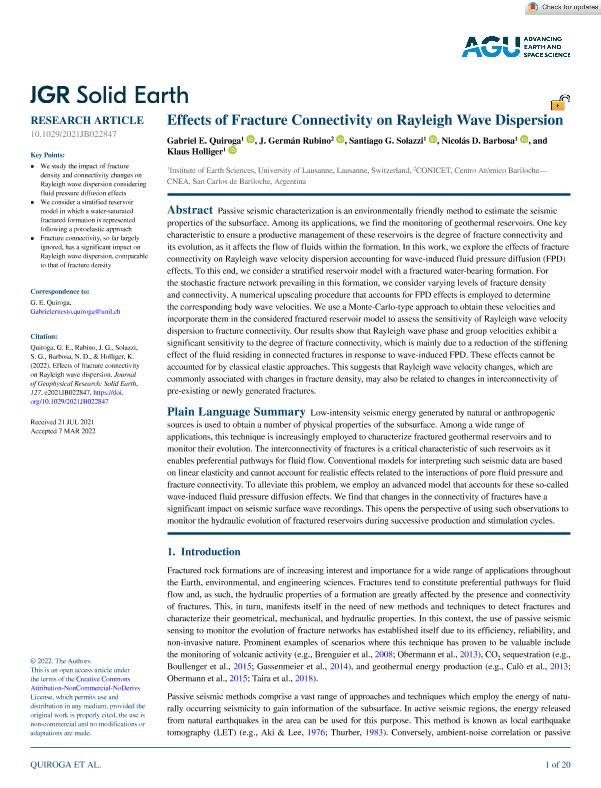Mostrar el registro sencillo del ítem
dc.contributor.author
Quiroga, Gabriel E.
dc.contributor.author
Rubino, Jorge German

dc.contributor.author
Solazzi, Santiago Gabriel

dc.contributor.author
Barbosa, Nicolás D.
dc.contributor.author
Holliger, Klaus

dc.date.available
2023-10-30T14:05:54Z
dc.date.issued
2022-03
dc.identifier.citation
Quiroga, Gabriel E.; Rubino, Jorge German; Solazzi, Santiago Gabriel; Barbosa, Nicolás D.; Holliger, Klaus; Effects of Fracture Connectivity on Rayleigh Wave Dispersion; Wiley; Journal of Geophysical Research: Solid Earth; 127; 3; 3-2022; 1-20
dc.identifier.issn
2169-9313
dc.identifier.uri
http://hdl.handle.net/11336/216373
dc.description.abstract
Passive seismic characterization is an environmentally friendly method to estimate the seismic properties of the subsurface. Among its applications, we find the monitoring of geothermal reservoirs. One key characteristic to ensure a productive management of these reservoirs is the degree of fracture connectivity and its evolution, as it affects the flow of fluids within the formation. In this work, we explore the effects of fracture connectivity on Rayleigh wave velocity dispersion accounting for wave-induced fluid pressure diffusion (FPD) effects. To this end, we consider a stratified reservoir model with a fractured water-bearing formation. For the stochastic fracture network prevailing in this formation, we consider varying levels of fracture density and connectivity. A numerical upscaling procedure that accounts for FPD effects is employed to determine the corresponding body wave velocities. We use a Monte-Carlo-type approach to obtain these velocities and incorporate them in the considered fractured reservoir model to assess the sensitivity of Rayleigh wave velocity dispersion to fracture connectivity. Our results show that Rayleigh wave phase and group velocities exhibit a significant sensitivity to the degree of fracture connectivity, which is mainly due to a reduction of the stiffening effect of the fluid residing in connected fractures in response to wave-induced FPD. These effects cannot be accounted for by classical elastic approaches. This suggests that Rayleigh wave velocity changes, which are commonly associated with changes in fracture density, may also be related to changes in interconnectivity of pre-existing or newly generated fractures.
dc.format
application/pdf
dc.language.iso
eng
dc.publisher
Wiley

dc.rights
info:eu-repo/semantics/openAccess
dc.rights.uri
https://creativecommons.org/licenses/by-nc-nd/2.5/ar/
dc.subject
FRACTURE CONNECTIVITY
dc.subject
POROELASTICITY
dc.subject
SURFACE WAVES
dc.subject.classification
Geoquímica y Geofísica

dc.subject.classification
Ciencias de la Tierra y relacionadas con el Medio Ambiente

dc.subject.classification
CIENCIAS NATURALES Y EXACTAS

dc.title
Effects of Fracture Connectivity on Rayleigh Wave Dispersion
dc.type
info:eu-repo/semantics/article
dc.type
info:ar-repo/semantics/artículo
dc.type
info:eu-repo/semantics/publishedVersion
dc.date.updated
2023-10-26T15:20:29Z
dc.identifier.eissn
2169-9356
dc.journal.volume
127
dc.journal.number
3
dc.journal.pagination
1-20
dc.journal.pais
Estados Unidos

dc.description.fil
Fil: Quiroga, Gabriel E.. Universite de Lausanne; Suiza
dc.description.fil
Fil: Rubino, Jorge German. Comisión Nacional de Energía Atómica. Centro Atómico Bariloche; Argentina. Consejo Nacional de Investigaciones Científicas y Técnicas. Centro Científico Tecnológico Conicet - Patagonia Norte; Argentina
dc.description.fil
Fil: Solazzi, Santiago Gabriel. Universite de Lausanne; Suiza. Consejo Nacional de Investigaciones Científicas y Técnicas; Argentina
dc.description.fil
Fil: Barbosa, Nicolás D.. Universite de Lausanne; Suiza
dc.description.fil
Fil: Holliger, Klaus. Universite de Lausanne; Suiza
dc.journal.title
Journal of Geophysical Research: Solid Earth
dc.relation.alternativeid
info:eu-repo/semantics/altIdentifier/url/https://onlinelibrary.wiley.com/doi/10.1029/2021JB022847
dc.relation.alternativeid
info:eu-repo/semantics/altIdentifier/doi/http://dx.doi.org/10.1029/2021JB022847
Archivos asociados
